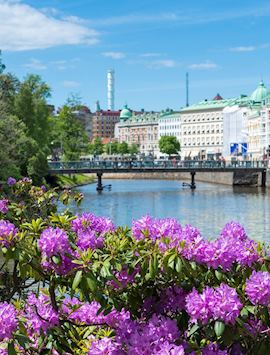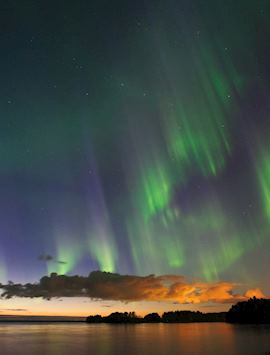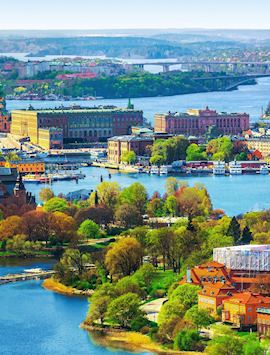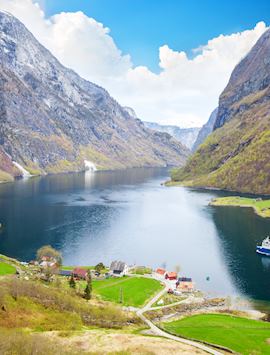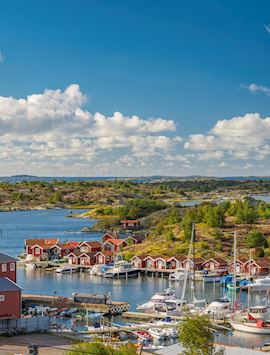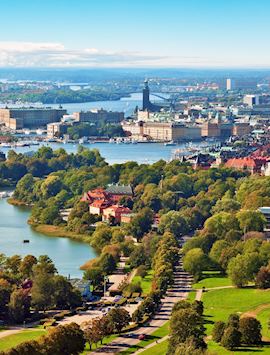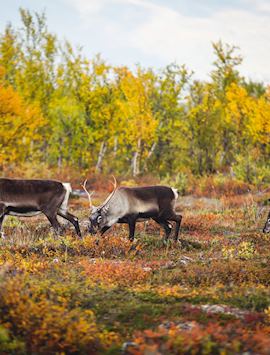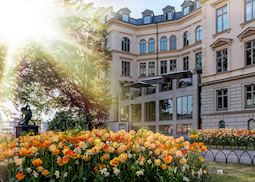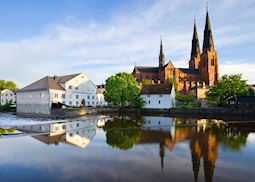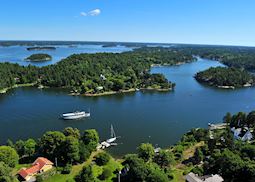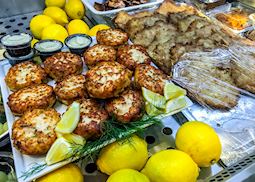Jump to:
Royal palaces, pickled herring, sunken warships and leafy parks, all in Sweden’s stylish capital, Stockholm.
Regal Stockholm is a stylish capital that’s happy to show off its embarrassment of cultural and historical riches. Known by locals as ‘The Beauty on the Water’, this glittering waterfront haven is spread over 14 islands on Lake Mälaren and the Baltic Sea. Despite that, it’s easy to navigate and compact enough to be comfortably walkable, with bridges, ferries and an efficient metro to ease the way.
Like other Nordic cities, Stockholm seamlessly blends the old and new. You can stroll along the cobbled lanes of the old town, Gamla Stan, and appreciate its brightly painted 17th- and 18th-century buildings and medieval cathedral, then cross a bridge to revel in modern Sweden’s minimalist style. This is also one of Europe’s greenest cities, literally and metaphorically, with a cultural emphasis on sustainability and many shady parks and nature preserves on the archipelago.
The city’s many restaurants and cafĂ©s offer both traditional dishes and cutting-edge haute cuisine with equal reverence. And the wealth of museums encompasses a wide range of subjects — Viking history, modern photography, Renaissance war ships, Nobel Prize winners and ABBA, to name a few.
Things to see and do in Stockholm
Gamla Stan
Stockholm’s Gamla Stan is one of Europe’s largest and best-preserved medieval cities. The busy main streets, Västerlånggatan and Österlånggatan, are packed with cafĂ©s, shops and other visitors. Just a block away, though, you can discover quiet, winding cobblestone alleys crammed with brightly painted buildings from the 17th and 18th centuries.
This is also where you can find the city’s major historical attractions: the Royal Palace (see below), and Stockholm’s 13th-century Storkyrkan cathedral, as well as the Nobel Prize Museum, the Swedish Parliament Building and Medeltidsmuseet (the Medieval Museum). A privately guided walking tour of the area can offer a great introduction to the enclave.
Kungliga Slottet & Museums
Unusually, this 17th-century palace is still a regular workplace where the kingdom’s business is seen to every day. The daily changing of the guard in the outer courtyard involves real soldiers protecting the monarchy that’s ruled Sweden for more than a millennium.
However, the palace has over 600 rooms, richly decorated in the grand Italian Baroque style of the era, and many are open to visitors. A highlight is Queen Kristina’s silver throne, on dazzling display in the opulent Rikssalen (the Hall of State). There are also five different museums here, including Livrustkammaren (the Royal Armoury) and the Skattkammaren (Royal Treasury).
Kungliga Djurgården, Stockholm’s playground
Once the royal hunting ground, today Djurgården is a leafy retreat where city residents go to relax. You can visit half a dozen excellent museums here, including the Vasamuseet (see below) and the ABBA museum. A highlight is Skansen, the world’s oldest open-air museum, built in 1891 to be ‘Sweden in miniature’, with replicas of more than 150 different traditional buildings.
To enjoy nature as the locals do, rent a bicycle and spend an afternoon exploring the Royal Djurgården National City Park. The jewel in the crown of Stockholm’s green spaces, this sprawling park combines well-tended forests and wide-open spaces just minutes from the heart of the city.
Visit the Vasa, one of maritime history’s great failures
In August of 1628, the royal warship Vasa was launched on her maiden voyage with great fanfare. Built at the command of King Gustav II Adolf, it was a massive flagship intended to be the pride of the fleet.
Barely off the dock, the Vasa hit a gentle swell and immediately sank — the hull was too narrow and no engineer dared point this out to the king. It lay at the bottom of Saltsjön, encased in mud, until 1961. Today, this bit of royal folly has been reconstructed and is the focus of one of the city’s most compelling museums. Almost everything you see is original, including the many (heavy) carved ornaments. You can also walk through a replica, and learn about the remarkable effort to recover and preserve the ship.
Sailing the archipelago
The Stockholm archipelago includes more than 30,000 islands, densely packed in the waters of the Baltic Sea, including the 14 islands that comprise the capital city. Each has its own personality and history.
There are a dozen nature preserves where you can hike or cycle. Norrtälje, you can visit an open-air archaeological museum that examines the Viking village that once thrived there. Take a ferry out to Vaxholm to visit a museum dedicated to naval defense or to Gustavsburg, to explore 170 years of porcelain making. If you’d prefer to explore by water, we can arrange for you to take a yacht tour.
Exploring Swedish gastronomy
There’s much more to Swedish food than what’s available at an Ikea cafeteria. From seafood like salmon and sill (pickled herring) to smoked reindeer to, yes, familiar classics like cinnamon rolls and meatballs, Sweden’s traditional cuisine reflects its history as a maritime nation, with a large swathe of its land lying north of the Arctic Circle.
A walking tour, guided by a local gourmet, can help you begin to explore the city’s food scene. You’ll visit Östermalms Saluhall, the oldest food market in Stockholm, and sip ultra-rich hot chocolate at a beloved local cafĂ© as you discover the joys of fika — a quintessentially Swedish ritual that involves chatting over a hot drink and a sweet treat.
Drottningholm
Dubbed the Versailles of Sweden, this sprawling complex of stately buildings was built in the early 1600s on Lovön Island, outside the capital, and is the permanent home of the royal family today. The sprawling complex is a UNESCO World Heritage Site thanks to its enormous manicured gardens and over-the-top rococo decor — a tribute to Sweden’s golden age under Queen Lovisa Ulrika and her son, King Gustav III, in the 1700s.
During a privately guided tour of the palace, you can visit highlights like the Chinese Pavilion, the gilded Drottningholm Court Theatre and the formal gardens, with their geometric box hedges and carefully sculpted topiaries.
Sweden’s cultural and historical heart, Uppsala
To delve into Sweden’s early history, consider a visit to Uppsala, the country’s oldest city. A thriving university town with a relaxed character and an abundance of fashionable cafĂ©s and bars, its youthful atmosphere belies the city’s historical importance.
This is home to Sweden’s oldest cathedral as well as Uppsala Castle, both the ruins of the original, where Queen Christina abdicated in 1648, and the current building, rebuilt in the 18th century. On a privately guided tour that also includes the charming town of Sigtuna, you can visit Gamla Uppsala, an archaeological dig that’s in the process of examining more than 300 burial mounds dating from the 6th to the 12th centuries.
Best time to visit Stockholm
With four distinct seasons and a wealth of indoor and outdoor attractions, Stockholm is a year-round destination. Spring blooms and dry weather offer a nice balance to the sometimes-fickle temperatures of March and April. Also, crowds are thin during these months.
May to August brings warm days, late sunsets and plenty of other visitors. The trees lining the streets and the many parks are all graced with glorious autumn foliage in September and October, thanks to cooling temperatures. Expect thinner crowds than during warmer months. December comes with Christmas markets, while January and February are excellent months for enjoying the snow.
Festivals, events and seasonal reasons to visit
- June: Sample the city’s cuisine from outdoor food vendors at Smaka på Stockholm (Taste of Stockholm).
- 21st June: Traditional festivals celebrate the summer solstice, known as Midsommardagen.
- October: Stockholm’s international Jazz Festival attracts fans and performers from around the world.
- 13th December: Sweden celebrates Saint Lucia’s Day with processions and crowns of lit candles.
- December: The city boasts several excellent Christmas markets selling trinkets, gifts, decorations and food.
who's been there
-
617-223-4521617-223-4117
- Make an inquiry
Suggested itineraries featuring Stockholm
Our itineraries will give you suggestions for what is possible when you travel in Stockholm, and they showcase routes we know work particularly well. Treat them as inspiration, because your trip will be created uniquely by one of our specialists.
Places near Stockholm
- Gothenburg 247 miles away
Photos of Stockholm
Accommodation choices for Stockholm
We've selected a range of accommodation options for when you visit Stockholm. Our choices usually come recommended for their character, facilities and service or location. Our specialists always aim to suggest properties that match your preferences.
-
![Lydmar Hotel terrace]()
Lydmar Hotel
Stockholm -
![Hotel Skeppsholmen Superior Double Room Park View]()
Hotel Skeppsholmen
Stockholm -
![Miss Clara façade]()
Miss Clara
Stockholm
Ideas for experiencing Stockholm
Our specialists seek out authentic ways to get to know the places that could feature in your trip. These activities reflect some of the experiences they've most enjoyed while visiting Stockholm, and which use the best local guides.
-
Sigtuna and Uppsala day trip ![Uppsala cathedral]()
Sigtuna and Uppsala day trip
Sigtuna and Uppsala day trip
Enjoy a day filled with history as you explore two important Swedish towns, Sigtuna and Uppsala, with a private guide. The tour is tailored to your interests, but you might see cathedrals, runestones, traditional wooden houses and medieval ruins.
View details -
Archipelago sailing adventure from Vaxholm ![Stockholm archipelago]()
Archipelago sailing adventure from Vaxholm
Archipelago sailing adventure from Vaxholm
Sail aboard a yacht to see some of the 30,000 islands that form Stockholm’s archipelago. Your captain will tailor the route to your interests, whether you want to focus on wildlife or local culture, with a traditional Swedish lunch served on board.
View details -
Walking food tour with local guide ![Food stall in Stockholm]()
Walking food tour with local guide
Walking food tour with local guide
This privately guided tour will give you a chance to explore the city’s lively gastronomic landscape, from modern chefs creating photogenic neo-Nordic dishes to traditional foods. You’ll also learn about the role that food and drink has played in the country’s culture.
View details


